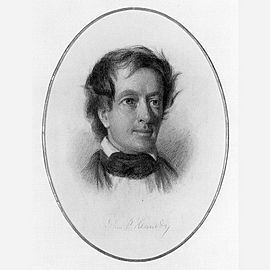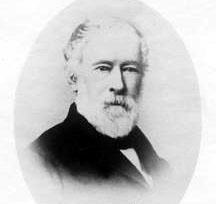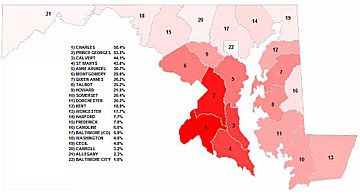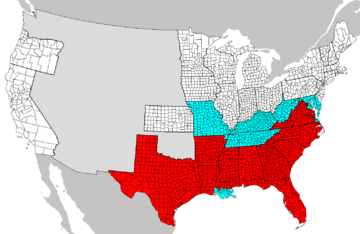John P. Kennedy facts for kids
Quick facts for kids
John P. Kennedy
|
|
|---|---|
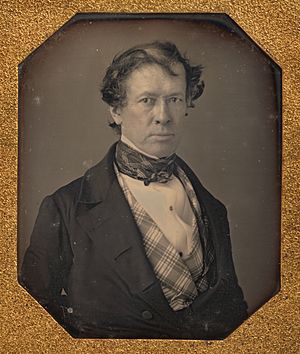 |
|
| 21st United States Secretary of the Navy | |
| In office July 26, 1852 – March 4, 1853 |
|
| President | Millard Fillmore |
| Preceded by | William Graham |
| Succeeded by | James C. Dobbin |
| Member of the U.S. House of Representatives from Maryland's 4th district |
|
| In office March 4, 1841 – March 3, 1845 |
|
| Preceded by | Solomon Hillen Jr. |
| Succeeded by | William Giles |
| In office April 25, 1838 – March 3, 1839 |
|
| Preceded by | Isaac McKim |
| Succeeded by | Solomon Hillen Jr. |
| Personal details | |
| Born |
John Pendleton Kennedy
October 25, 1795 Baltimore, Maryland, U.S. |
| Died | August 18, 1870 (aged 74) Newport, Rhode Island, U.S. |
| Political party | Whig |
| Spouses | Elizabeth Gray Margaret Hughes |
| Education | Baltimore College (BA) |
| Military service | |
| Allegiance | |
| Branch/service | |
| Battles/wars | War of 1812 |
John Pendleton Kennedy (born October 25, 1795 – died August 18, 1870) was an important American writer, lawyer, and politician. He served as the United States Secretary of the Navy from 1852 to 1853. He was also a U.S. Representative for Maryland.
Kennedy was a big supporter of new ideas. He helped the U.S. government study and use the telegraph, which changed how people communicated. He also worked to end slavery in Maryland. This was important because Maryland was not part of the Confederacy, so the Emancipation Proclamation did not free slaves there.
He also believed in religious tolerance, meaning people should be free to practice any religion. Kennedy helped create or save important places like St. Mary's City, Maryland (where Maryland was first settled) and institutions like the Peabody Library.
Contents
Early Life and Education
John Pendleton Kennedy was born in Baltimore, Maryland, on October 25, 1795. His father, John Kennedy, was an Irish immigrant and merchant. His mother, Nancy Pendleton, came from an old Virginia family. John went to private schools and graduated from Baltimore College in 1812. His brother, Anthony Kennedy, later became a U.S. Senator.
John's college studies were stopped by the War of 1812. He joined the army in 1814. He was part of a unit called the "Baltimore 5th," which included many rich merchants and lawyers. Kennedy wrote funny stories about his time in the army, like when he lost his boots and had to march in dancing shoes!
However, the war was serious. Kennedy fought in the Battle of Bladensburg, where the British threatened Washington, D.C. He also fought in the Battle of North Point, which helped save Baltimore from being burned. During the war, he met George Peabody, who later helped fund the Baltimore and Ohio Railroad.
Kennedy spent his summers in Martinsburg, West Virginia, studying law. In 1829, he married Elizabeth Gray, whose father was a rich mill-owner. Her money allowed Kennedy to take a break from his law practice for ten years to focus on writing.
Literary Achievements
Even though he became a lawyer in 1816, Kennedy was more interested in writing and politics. He joined the Delphian Club, a group of writers in Baltimore. His first writing project was a magazine called the Red Book, which he published with his friend Peter Hoffman Cruse.
Kennedy wrote several novels. His most famous book was Swallow Barn, or A Sojourn in the Old Dominion, published in 1832. Another important novel was Horse-Shoe Robinson, published in 1835. This book earned him a respected place in American literature.

Kennedy was friends with many famous writers, including James Fenimore Cooper, Charles Dickens, Washington Irving, Edgar Allan Poe, and William Makepeace Thackeray. In 1858, Thackeray asked Kennedy for help with a chapter in his novel The Virginians. Kennedy wrote parts of that chapter, which made the descriptions very accurate.
In 1833, Kennedy helped Edgar Allan Poe get his story "MS. Found in a Bottle" published. He also introduced Poe to Thomas Willis White, an editor. Kennedy sometimes used pen names like 'Mark Littleton' for his writings, especially for his political satires.
Political Career
Kennedy enjoyed politics more than being a lawyer. He left the Democratic Party because he disagreed with President Andrew Jackson. He became an active member of the Whig Party, which supported business interests in Baltimore.
He was elected to the Maryland House of Delegates in 1820. He strongly supported building the Chesapeake and Ohio Canal. In 1838, Kennedy was elected to the U.S. House of Representatives.
Kennedy was a strong supporter of the B&O Railroad. He gave speeches and worked to get laws passed that helped the railroad expand. He became a board member of the B&O Railroad and helped it grow westward.
He was re-elected to Congress in 1840 and 1842. Kennedy played a key role in getting $30,000 from Congress to test Samuel Morse's telegraph. This was a huge amount of money at the time. These tests proved the telegraph worked, leading the government to use this new technology. This changed communication and helped the U.S. economy grow.
In 1847, Kennedy became the Speaker of the Maryland House of Delegates. He continued to use his influence to help the B&O Railroad.
In July 1852, President Millard Fillmore appointed Kennedy as the United States Secretary of the Navy. During his time in office, Kennedy helped organize four important naval trips. One of these sent Commodore Matthew C. Perry to Japan. Another sent Lieutenants William Lewis Herndon and Lardner Gibbon to explore the Amazon River area.
Kennedy was considered as a possible Vice President alongside Abraham Lincoln in 1860, but he was not chosen. He strongly supported the Union during the American Civil War. He also supported the Emancipation Proclamation, which freed slaves in Confederate states.
Since the Emancipation Proclamation did not free slaves in Maryland (because it was not a Confederate state), Kennedy used his influence to push for a state law to end slavery there. This law was passed in 1864.
Support for Religious Freedom
Kennedy wanted to build a monument to celebrate the founding of Maryland and the start of religious freedom in St. Mary's City, Maryland. His idea led to the creation of St. Mary's College of Maryland in 1840. This school was meant to be a "Living Monument" to religious freedom.
Kennedy once said:
All the world outside of these portals was intolerant, proscriptive, vengeful against the children of a dissenting faith. Here only in Maryland, throughout all this wide world of Christendom, was there an altar erected and truly dedicated to the freedom of Christian worship. Let those who first reared it enjoy the renown to which it has entitled them.
John Pendleton Kennedy, On memorializing the birth of religious freedom in St. Mary's City Maryland
Earlier, as a state lawmaker, Kennedy helped repeal a law that treated Jewish people unfairly in Maryland courts. He also helped Irish Catholic immigrants, who faced a lot of discrimination. However, in the 1850s, he did suggest limiting new immigration to Maryland. He worried that too many new immigrants might overwhelm the economy.
Opposition to Slavery
Kennedy's opposition to slavery grew stronger over his lifetime. At first, his views were milder. But by the time of the Civil War, he became a very strong opponent of slavery.
He wrote about his opposition in his books and spoke about it as a politician. Kennedy once said that hearing Frederick Douglass speak helped him see slavery as a "curse."
His 1830s novel Swallow Barn criticized slavery. However, some of his strongest criticisms were removed from the book before it was published. This might have been because he lived in Maryland, a slave state, and being too open about his views could have been dangerous.
Historians debate whether his early, milder opposition was a way to stay safe in a pro-slavery state. Others believe his views simply changed over time. Even so, Swallow Barn predicted that slavery would eventually ruin the Southern states. This was written 29 years before the Civil War began.
During the Civil War
Before the Civil War, Kennedy thought slavery should be ended slowly to avoid a war. He believed civil wars were the most destructive.
But once the war started, he strongly opposed slavery and called for "immediate emancipation." As the war went on, his demands for ending slavery became even stronger. He signed a political pamphlet in Maryland that called for slavery to end right away.
Historians agree that Kennedy was always critical of slavery to some degree. By the Civil War, he was very much against it and against the Confederacy. When the Emancipation Proclamation did not apply to Maryland, Kennedy played a key role in ending slavery in the state.
Maryland was a slave state but did not join the Confederacy. So, President Lincoln's Emancipation Proclamation did not free slaves there. Only Maryland itself could end slavery.
On December 16, 1863, Kennedy spoke at a meeting of the Union Party of Maryland. He supported a motion to work for "Immediate emancipation (of all slaves) in Maryland." Because he was a respected author and former Speaker of the Maryland General Assembly, his support was very important. The motion passed.
For the next year, Kennedy and other anti-slavery leaders campaigned across the state. He signed a pamphlet calling for "immediate emancipation." On November 1, 1864, Maryland citizens voted to abolish slavery. It was a close vote, with only about 1,000 votes deciding the outcome.
Work with Cultural and Educational Institutions
Kennedy worked closely with George Peabody to establish the Peabody Institute. This institute later became the Peabody Library and the Peabody Conservatory of Music, both now part of Johns Hopkins University. Kennedy served on the first board of trustees and helped write the institute's mission.
He also played a key role in creating St. Mary's Female Seminary, now known as St. Mary's College of Maryland. This school was founded as a "Living Monument to religious freedom" because it was on the site of Maryland's first colony, where religious freedom began in America.
Kennedy was also important in getting the state to protect and study St. Mary's City, Maryland. This was the abandoned site of Maryland's first colony and capital. His idea led to the creation of Historic St. Mary's City, a state-run archaeological and historical site today.
During his time as Secretary of the Navy, Kennedy asked for the creation of the United States Naval Academy Band in Annapolis in 1852. This band is still active today.
Contributions to Science and Technology
Federal Acceptance of the Telegraph
While in Congress, John Pendleton Kennedy was the main reason Congress approved $30,000 to test Samuel Morse's telegraph system. This was the first electronic way to communicate over long distances. The government tests proved the telegraph worked. This led to the U.S. government adopting the technology, which created the American telegraph system. This invention changed communication and helped the United States grow economically.
Commissioner of the 1867 Paris Exposition
Kennedy was a commissioner for the 1867 Paris Exposition. This was a big international fair in Paris, France, that showed off science, technology, and art. Forty-two nations participated, and there were over 50,000 exhibits. It was the second World's Fair.
Later Life and Legacy
Kennedy retired from public office in March 1853. However, he remained active in politics. He supported President Fillmore in the 1856 election. Kennedy also played a key leadership role in the Union Party's successful effort to end slavery in Maryland in 1864. After the American Civil War, he supported giving amnesty (forgiveness) to former rebels.
Kennedy died in Newport, Rhode Island, on August 18, 1870. He is buried in Greenmount Cemetery in Baltimore, Maryland.
In his will, Kennedy asked that his journals, letters, and other writings be kept safe at the Peabody Institute. Today, two large collections of his papers are at the Peabody Institute and the Enoch Pratt Free Library in Baltimore.
Two naval ships were named after him: USS John P. Kennedy and USS Kennedy (DD-306).
Books and Essays
- The Red Book (1818–19, two volumes)
- Swallow Barn: Or, A Sojourn in the Old Dominion (1832)
- Horse-Shoe Robinson: A Tale of the Tory Ascendency in South Carolina, in 1780 (1835)
- Rob of the Bowl: A Legend of St. Inigoe's (1838)
- Annals of Quodlibet (1840)
- Defence of the Whigs (1844)
- Memoirs of the Life of William Wirt (1849, two volumes)
- The Great Drama: An Appeal to Maryland (1861)
- The Border States: Their Power and Duty in the Present Disordered Condition of the Country (1861)
- Autograph Leaves of Our Country's Authors (1864, co-edited)
- Mr. Paul Ambrose's Letters on the Rebellion (1865)
- Collected Works of John Pendleton Kennedy (1870–72, ten volumes)
- At Home and Abroad: A Series of Essays: With a Journal in Europe in 1867–68 (1872, essays)
See also
 In Spanish: John P. Kennedy para niños
In Spanish: John P. Kennedy para niños


